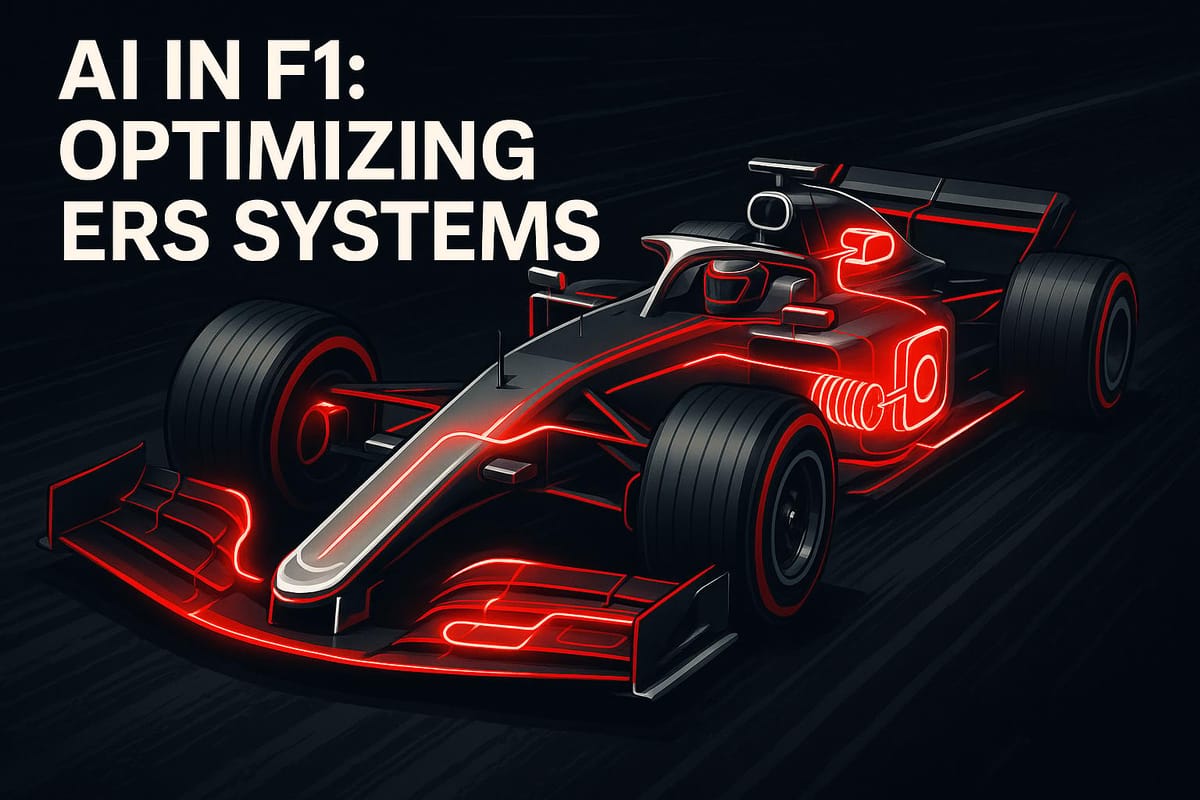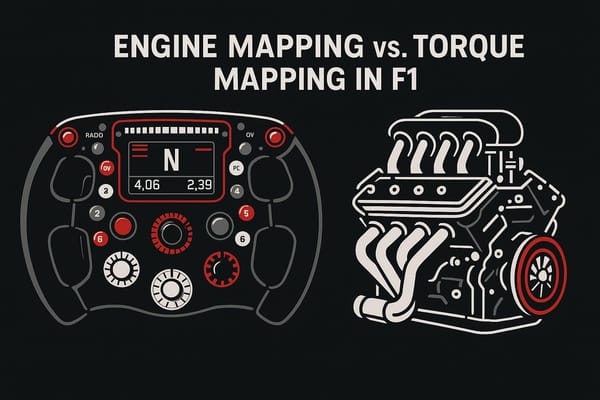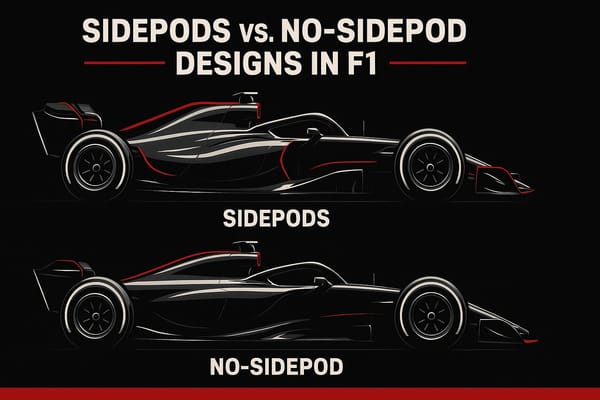AI in F1: Optimizing ERS Systems
Explore how AI is revolutionizing Energy Recovery Systems in Formula 1, enhancing performance, efficiency, and sustainability on and off the track.

AI is transforming Formula 1 racing by making Energy Recovery Systems (ERS) smarter, faster, and more efficient. Here's how:
- What is ERS? It's a hybrid system that recovers energy from braking (MGU-K) and exhaust heat (MGU-H), stores it in batteries (ESS), and deploys it for extra power during races.
- Why AI matters: AI analyzes real-time data to improve energy recovery, reduce fuel use, and optimize deployment strategies.
- Key benefits: Faster lap times, better fuel efficiency, and smarter race strategies.
- Future impact: The 2026 F1 rules will demand even more from ERS systems, and AI will play a critical role in meeting these challenges.
AI isn't just shaping F1 performance; it's also influencing energy management in hybrid and electric road cars, making them more efficient and eco-friendly.
How AI Is Changing Formula 1 Forever (And Why Drivers ...
ERS Basics in F1 Power Units
Understanding the basics of ERS (Energy Recovery System) is key to seeing how AI improves F1 power units. ERS captures energy that would otherwise go to waste, turning it into extra power and efficiency. It works alongside the internal combustion engine in a hybrid setup.
Main ERS Components: MGU-K, MGU-H, and Batteries
The ERS has three main parts that recover, store, and use energy:
Motor Generator Unit-Kinetic (MGU-K)
This part converts braking energy into electricity. The stored energy is then used to boost acceleration during races.
Motor Generator Unit-Heat (MGU-H)
Sitting between the turbine and compressor in the exhaust system, the MGU-H captures energy from exhaust gases. It also helps reduce turbo lag by keeping the turbocharger running efficiently.
Energy Storage System (ESS)
The ESS is a lithium-ion battery pack designed for quick charging and discharging. It stores energy from the MGU-K and MGU-H and provides power when it’s most needed during a race.
| ERS Component | Function | Impact |
|---|---|---|
| MGU-K | Converts braking energy | Boosts acceleration |
| MGU-H | Recovers exhaust energy | Reduces turbo lag |
| ESS | Stores recovered energy | Delivers power during critical moments |
How ERS Impacts Race Performance
ERS plays a big role in race performance in several ways:
Faster Lap Times
Using ERS effectively allows for quicker exits from corners, shaving time off laps.
Better Fuel Efficiency
By recovering and reusing energy, F1 cars can perform at a high level while using less fuel compared to older, non-hybrid designs.
Strategic Flexibility
Teams adjust ERS usage based on track layouts and race conditions. Stored energy can be deployed smartly for overtaking or defending positions.
These energy systems have reshaped F1 strategies, making energy management just as important as tire and fuel strategies. The performance boost provided by ERS forms the foundation for the AI-driven improvements that will be explored next.
AI Methods for ERS Improvement
Machine learning algorithms analyze real-time data to fine-tune energy efficiency during races. This constant analysis allows for on-the-spot adjustments, ensuring the car performs at its best throughout the competition.
AI systems actively manage ERS (Energy Recovery System) performance by balancing energy harvest and deployment. By integrating telemetry and data like vehicle position, battery levels, and weather conditions, these systems determine the best energy management strategies. With each lap, the AI refines its approach, responding to changing race conditions.
Machine learning also predicts ERS performance in various race scenarios. By studying historical race data, practice runs, and qualifying results, AI creates strategies specifically designed for the unique demands of each circuit.
Early AI applications have already led to better energy recovery, more accurate power deployment, and smarter battery management. These improvements highlight AI's growing role in pushing F1 performance while staying within technical regulations. As machine learning technology advances, even more sophisticated energy management strategies are expected to emerge.
Industry and Environmental Effects
AI-powered ERS systems in Formula 1 are reshaping how energy is managed on the track while also influencing advancements in road vehicle efficiency. These developments not only enhance racing performance but also contribute to more efficient and sustainable technologies for everyday vehicles.
Supporting F1's Carbon Goals
AI-enhanced ERS systems play a key role in Formula 1's efforts to reduce its environmental impact. By optimizing energy recovery, these systems help lower fuel consumption and emissions. As the technology evolves, it will further align with the sport's goal of achieving carbon neutrality.
Impact on Road Cars
The technology and knowledge gained from Formula 1 are making their way into hybrid and electric vehicle designs. Car manufacturers are using AI algorithms to improve battery performance and energy management, which benefits both racing and the development of more efficient and eco-friendly road vehicles.
Comparing Standard and AI-Driven ERS
AI-driven ERS solutions offer quicker responses, better energy recovery, and smarter battery management. These advancements lead to consistent lap times, improved reliability, and less frequent maintenance needs. Such progress highlights how AI is shaping the future of ERS technology and contributing to Formula 1's technical evolution.
Next Steps for AI in F1 ERS
2026 Power Unit Rules and ERS
The 2026 Formula 1 regulations will require an equal split between combustion and electric power, with the MGU-K output increasing to 350 kW. This is a massive 192% jump from current systems, demanding advanced AI tools to optimize performance.
The Mercedes-AMG PETRONAS F1 Team is already ahead, using reinforcement learning models to boost energy recovery by 20-25% per lap in simulations. Their collaboration with G42's Presight.ai platform has slashed strategy computation time during races from 12 minutes down to just 90 seconds.
The removal of the MGU-H brings new energy management challenges. Red Bull Racing, in partnership with Google DeepMind, is leveraging temporal convolutional networks to analyze track-specific energy needs. This approach has cut energy mismatches by 15% in prototype tests. These advancements highlight how AI is shaping the sport's technical evolution.
Research and Team Partnerships
To meet the demands of the 2026 regulations, F1 teams are teaming up with tech companies and academic institutions. For example, Ferrari is working with Stanford University's Energy Systems Lab on quantum-inspired algorithms, achieving a 40% improvement in battery thermal management optimization compared to traditional methods.
Aston Martin's technical director shared:
"Our AI models have improved ERS deployment accuracy by 18% in simulator tests, processing data from over 300 race simulations to optimize energy management strategies".
Here’s a breakdown of some key partnerships and their results:
| Team | Partner | Innovation | Performance Gain |
|---|---|---|---|
| Mercedes-AMG | G42 | Real-time strategy optimization | 90-second decision cycles |
| Alpine F1 | Siemens | Predictive maintenance | 12% less battery degradation |
| Williams | AWS SageMaker | Dynamic MGU-K control | 2.1% efficiency improvement |
AlphaTauri, partnering with Oracle, has developed edge-computing solutions that achieve 93% local AI inference accuracy on demanding tracks like Monaco. These systems meet the FIA’s strict computational limits while delivering sub-2ms decision cycles.
Meanwhile, Bosch and Haas F1 have made strides in energy optimization. Their use of generative adversarial networks has improved energy density by 5.7% in lab tests. These innovations align with Formula 1’s goal of adopting 100% sustainable fuels by 2026.
Conclusion
The advanced ERS strategies and AI technologies discussed earlier are reshaping how F1 approaches energy recovery systems, with benefits extending far beyond the racetrack. AI is optimizing energy management in hybrid powertrains, impacting both high-performance racing and everyday road vehicles.
This dual focus improves on-track performance while aligning with global goals for greener, more efficient transportation. These advancements highlight current progress and open the door for future innovations in F1 and the automotive industry.
As teams and researchers push the boundaries of AI-driven ERS, Formula 1 sets the pace in combining top-tier performance with environmentally conscious practices.
FAQs
How does AI enhance the performance of Energy Recovery Systems (ERS) in Formula 1 cars?
AI plays a vital role in optimizing Energy Recovery Systems (ERS) in Formula 1 cars by improving how energy is harvested, stored, and deployed during a race. Through advanced algorithms and real-time data analysis, AI helps teams predict the most efficient moments to recover and release energy, ensuring maximum performance without wasting resources.
Additionally, AI analyzes vast amounts of telemetry data to fine-tune ERS settings for different track conditions, driver behavior, and race strategies. This allows teams to adapt quickly to changing circumstances, giving them a competitive edge on the track.
What challenges could F1 teams face with the 2026 ERS regulations, and how might AI help overcome them?
The 2026 ERS (Energy Recovery System) regulations are expected to introduce stricter efficiency standards and push for greater energy recovery from hybrid power units. These changes might present several challenges for F1 teams, such as optimizing energy storage, managing thermal efficiency, and integrating new components into existing car designs.
AI can play a pivotal role in addressing these challenges by analyzing vast amounts of performance data to fine-tune ERS systems. For example, machine learning algorithms can predict optimal energy deployment strategies during races or simulate various scenarios to improve development efficiency. By leveraging AI, teams can adapt more quickly to regulatory changes and maintain competitive performance on the track.
How are AI-driven ERS advancements in F1 shaping the future of hybrid and electric vehicles?
AI-driven advancements in Energy Recovery Systems (ERS) in Formula One are having a significant impact on the development of hybrid and electric road vehicles. By optimizing how energy is harvested, stored, and deployed during a race, these technologies are pushing the boundaries of efficiency, battery management, and energy recovery techniques.
The innovations seen in F1, such as predictive algorithms and real-time energy optimization, are directly influencing the design of more efficient hybrid and electric vehicles for consumers. These advancements help improve battery life, enhance energy regeneration during braking, and create smarter energy distribution systems, paving the way for more sustainable and high-performance road vehicles.




